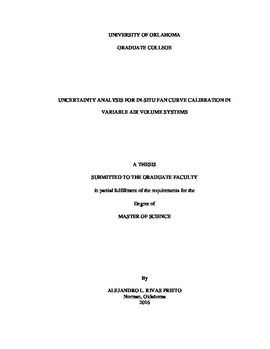| dc.description.abstract | In order to obtain in-situ fan performance curves for variable air volume (VAV) air handling units (AHUs) with predicted uncertainties, airflow measurements for an extended time and a tailored calibration procedure were proposed and validated in this work.
To obtain airflow measurement for an extended time, traverse measurements through the Equal-Area method were first conducted to select 3 sampling points (3-P) that represented the average velocity at a measurement plane. Next, through statistical analysis, additional uncertainty generated when reducing the number of sampling points was accounted for in terms of sampling time, reduced number of sampling points, measurement location, and comparison to common airflow measurement stations (AFMS). As a result of these analyses, it was found that for sampling times of 60 seconds, uncertainties below 5% can be expected from 3-P measurements when airflow velocity is above 800 fpm. Analysis showed that for return air (RA) measurements where velocities below 800 fpm are common, more than 3-P would be necessary to comply with 5% accuracy per ASHRAE Standard 111 [2008] requirements.
Next, it was demonstrated through comparison of measurement conditions and uncertainties for supply air (SA) that a relationship between measurement location and uncertainty of the 3-P measurement exists. Finally, the results showed that AFMS utilized more sampling points than necessary to achieve 5% accuracy in every test case. Performing airflow measurements with a tailored selection of sampling points was more effective than following cross-sectional area-based industry guidelines.
Upon the completion of the airflow uncertainty analyses, a calibration procedure for VAV AHUs was also produced and tested to obtain in-situ fan performance curves. In addition, based on the ANSI/ASHRAE Standard 51 [1999], an uncertainty analysis was performed on adjusted measurements by fan laws to build in-situ fan performance curves. Uncertainty bands at 95% confidence showed that previously defined airflow measurement uncertainty is the most sensible variable. Results showed that while application of fan laws can be applicable to return fans (RFs), higher uncertainties can be expected as airflow velocities below 800 fpm are common. Nevertheless, since SA average velocities were generally above 800 fpm, narrow uncertainty intervals were observed.
In conclusion, a practical and reliable approach for in-situ fan performance curves calibration was explored using statistical analysis and uncertainty propagation of airflow, fan head, and fan power uncertainties. Airflow measurements for extended sampling times were successfully achieved after developing a prototype holding bracket design for reducing field technician dependency. Finally, a VAV AHU calibration procedure for obtaining in-situ fan performance curves with actual range and visible system effect impacts was successfully applied and validated through this thesis work. | en_US |
